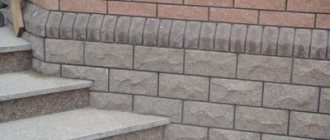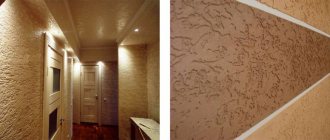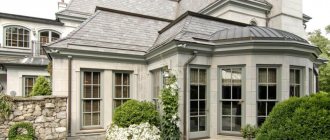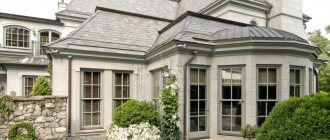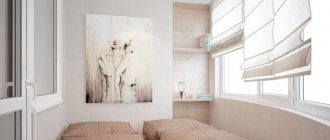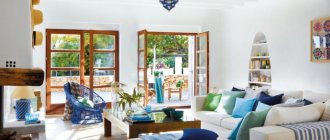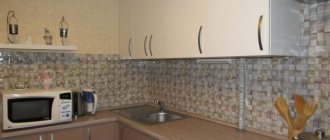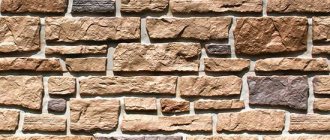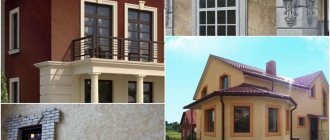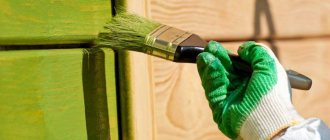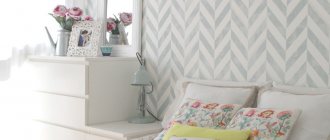To protect the house from external adverse influences and give it a decorative finish, facade plaster is used. Decorative facade plaster is durable. It is divided into many types, each of which has its own properties. An affordable price makes this finishing material in demand in the construction market.
The plaster used to decorate external walls differs in its manufacturing method from that used inside the house.
Facade plaster for external use contains more high-strength cement, which means it is stronger. Diluted in a ratio of 1:3 cement and sand. Each type of plaster has its own additional components.
Types of facade plasters
Decorative components in the composition of the material indicate its group:
A uniform dough-like mass constitutes a texture group. Color may vary depending on color scheme. It is added to the mixture or during the process of painting the facade surface.
Thanks to its high plasticity, real masterpieces are created on the walls - exquisite and artistic. The fact is that the composition contains natural fibers from cotton, flax and even... ground brick.
In the photos of façade finishing with plaster presented on the Internet, you can find many original compositions. They have unusual bright names “American”, “Venetian” and “Popcorn”.
A heterogeneous mass with granular inclusions is a structural group. The main component is a binder. To work, it is diluted either with water or a special solvent.
This facade decor is called, respectively, “Fur Fur”, “Lamb” or “Bark Beetle”. The decorated façade with bark beetle plaster is of the greatest interest to many home owners.
Application area of plaster
As you know, various building materials are used to build a country house: stone and brick, wood and concrete, aerated concrete and foam blocks. As for plaster for finishing the facade of a house, its type depends on the base of the wall, since the materials must be combined with each other, which will form a durable and attractive coating. If you believe the recommendations of manufacturers and specialists, we can draw the following conclusions:
- For exterior finishing of a wooden surface, you need to use cement-sand or acrylic plaster. In some cases, it is permissible to use silicate and silicone mixtures (there are special varieties recommended by manufacturers). As for gypsum compositions, their use is unacceptable.
- For concrete and brick, gas blocks and foam blocks, you can use any type of plasters; the choice of finishing material depends on its cost and decorative properties, price and reputation of the manufacturer.
- To cover mineral substrates you can and should use silicate plaster.
- You can also coat metal with plaster, but first you need to prepare it (degrease and thoroughly clean it), after which a primer and plaster mesh are applied.
- To finish ventilated facades, you can use acrylic, silicate or silicone plaster, but it is important to carry out preliminary work to ensure good adhesion (the use of a primer and construction mesh will be required).
Cost of façade finishing work
The plaster of the façade is assessed depending on the number of decorative components and the height of the building itself. For example, the price of finishing a façade with “Bark Beetle” plaster, together with wall insulation work, costs on average one and a half thousand rubles per square meter.
Painting and impregnation with a protective composition
Facade paints are widely used in the external decoration of cottages, reviving simple and complex architectural forms. This solution can be seen in house designs with brick, aerated concrete, and frame walls. Modern paint and varnish coatings are durable, resistant to weather factors (sun, rain, frost), and contain up to 40 different components. Their cost directly depends on this.
For example, most private houses in Europe are yellowish, gray, terracotta, brown in color - this expresses the characteristic habit of saving. Inexpensive pigments based on ferrous oxides are “champions” in light fastness. It is worth noting new high-tech compounds that have the property of repelling dirt, like lotus petals that never get wet in water.
8. Combined design of a country house in gray and brown tones
9. For painting a private building, an interesting tone of light olives was chosen, against which bright elements benefit
The shade can be anything, it is important that it matches its architecture, idea, and finally the surrounding landscape. In most cases, people choose bright and light shades, but there are examples where black looks very original and not at all intimidating.
10. Minimalist architecture is ideally emphasized with a black shade
11. Black color beautifully sets off the yellow-red shades of autumn that are present in wooden structures
12. The design successfully combines a combination of black, gray, and a little red, helping the house to blend harmoniously with the surrounding nature
Wooden buildings require protection from the elements to an even greater extent than brick ones. Traditionally, bio-moisture-proof impregnations are used for this, transparent and tinted, if you want to preserve the structure of the wood. But paints are also often used - their advantage is the huge number of possible tinting shades. For solid (plastered) surfaces, matte painting is better, and for small-elements (stone, wood) - semi-gloss.
13. The azure shade in combination with white doors and windows gives the country cottage a “fairy-tale” and elegant look
14. A private country house with half-timbered finishing looks like a watercolor picture
15. The amazing color of the crimson sunset will not allow such a structure to get lost in the surrounding landscape (painting)
Pros and cons of facade plaster
pros
- The application method is very simple. A person without certain skills will be able to cope with such work on his own;
- environmental cleanliness;
- texture, colors, application methods are very different;
- aesthetics and quality;
- resistance to strong external influences and durability;
- unpretentious operation.
Minuses
- complete finishing takes significantly more time and energy consumption - the reason for hiring special teams;
- does not last as long as clinker, brick, ventilated facades;
- the material is selected more carefully depending on the surface and material of the walls;
- if workers do not follow the technology, the plaster will not last so long, and the main wall, for example made of aerated concrete, may partially collapse.
Decorative properties
As mentioned earlier, one of the main advantages of facade plaster is decoration. Thanks to its decorative properties, you can choose different colors and textures for the walls.
The color palette of plaster is very diverse. To achieve the desired textures, you can add ceramic granules or stone chips. The surface texture can be changed using a grater. This creates interesting patterns.
In this case, Travertine facade plaster will look quite attractive. It is easily applied to hide defects on the wall surface. Compared to other plaster mixtures, it has great durability and resistance to mechanical damage.
Another popular finishing mixture is bark beetle plaster. Gives the walls the appearance of a wood surface with traces of insect pest activity. Very interesting and beautiful pattern. Able to hide unevenness and defects of walls. The base of the plaster can be acrylic or gypsum.
There is a universal material on the construction market - marble chips for facades. It is good because it is used not only for the exterior decoration of the walls of the house, but also for the interior.
Based on the type of grain, it is divided into several fractions. Resistant to mechanical stress, can not fade in the sun for a long time. Resistant to temperature changes, can be used on any surface.
Photo of façade finishing with plaster
Brick finish
This material is a symbol of good quality.
Clinker brick also managed to embody respectability. Brick cladding is carried out during the construction of the house and is calculated in the project by the architect. The appearance of such a structure will not require additional decor. Of interest is the masonry design of the unsightly façade. What type of unpresentable buildings can be turned into examples of aesthetics using this technology?
in houses whose facades are decorated with bricks, it is warm in winter and cool in summer
Duplicating wooden bases with a brick wall does not make much sense. Unless you build a ventilated façade with an air gap. In this case, wooden surfaces will not rot prematurely under the influence of condensation. You should not count on the fact that finishing the wooden facade of a private house with brick will improve its thermal insulation qualities. In order to obtain a similar effect, it is necessary, at a minimum, to ensure the absence of air sinuses. This can only be done by ensuring a tight fit of the decorative layer, which is impossible in this case. In houses of other buildings, the density of interaction is achieved by pouring liquid foam or creating a ventilated facade lined with mineral wool.
Brickwork implies the presence of a strong foundation, therefore, the foundation of the building itself will have to be expanded and strengthened. It is correct to do this with waterproofing materials, since the brick itself readily absorbs moisture.
decorative aged brick in the facade decoration allows you to get a more original exterior
Whatever the wall of the house is made of, it must certainly be connected to the facing masonry with special flexible fasteners. There should be about 7 pieces of such bundles per square meter.
Brick cladding has height restrictions. The duplicate wall should not be higher than five meters (together with the pediment this figure will be equal to seven meters), otherwise you will have to forget about stability and strength.
If you are already generous in decorating the exterior of your home with elite-class materials, then do not skimp on decorative elements. Arched moldings, cornices and other decorative forms will help revive the texture of a smooth wall and break up the monotony of the masonry.
combining brick and stone when decorating a modern house
Feel free to combine bricks of different colors. If this is not possible, make the facade of a private house more attractive with the help of a contrasting shade of the mortar used for masonry. Pigment dyes will help give the desired color. This is a great way to highlight the elegance of the brick texture!
Glass facades
11
This solution is also not traditional. Fans of futurism will appreciate it. Glass panels on the facade will make the house unusual and guaranteed to be memorable.
This type of finish, contrary to popular belief, is quite durable. Glass of different classes is used to make the material. The glass facade can easily withstand impacts, so it cannot be broken by a stone. It cannot be hacked. There are even bulletproof types of panels. Of course, such beauty is not a cheap pleasure, which is why most often the facades of office buildings of powerful corporations are hidden behind such decoration.
using glass you can create non-standard facades of private houses
To decorate the facade of an ordinary private house, laminated glass, which is considered one of the types of expensive glass panels, is quite sufficient. It has a layered structure. A PVC film is placed between the glass plates.
You can use reflective or absorbing glass to decorate a country building. The first will create additional shine and attract attention, the second will shade the interior.
